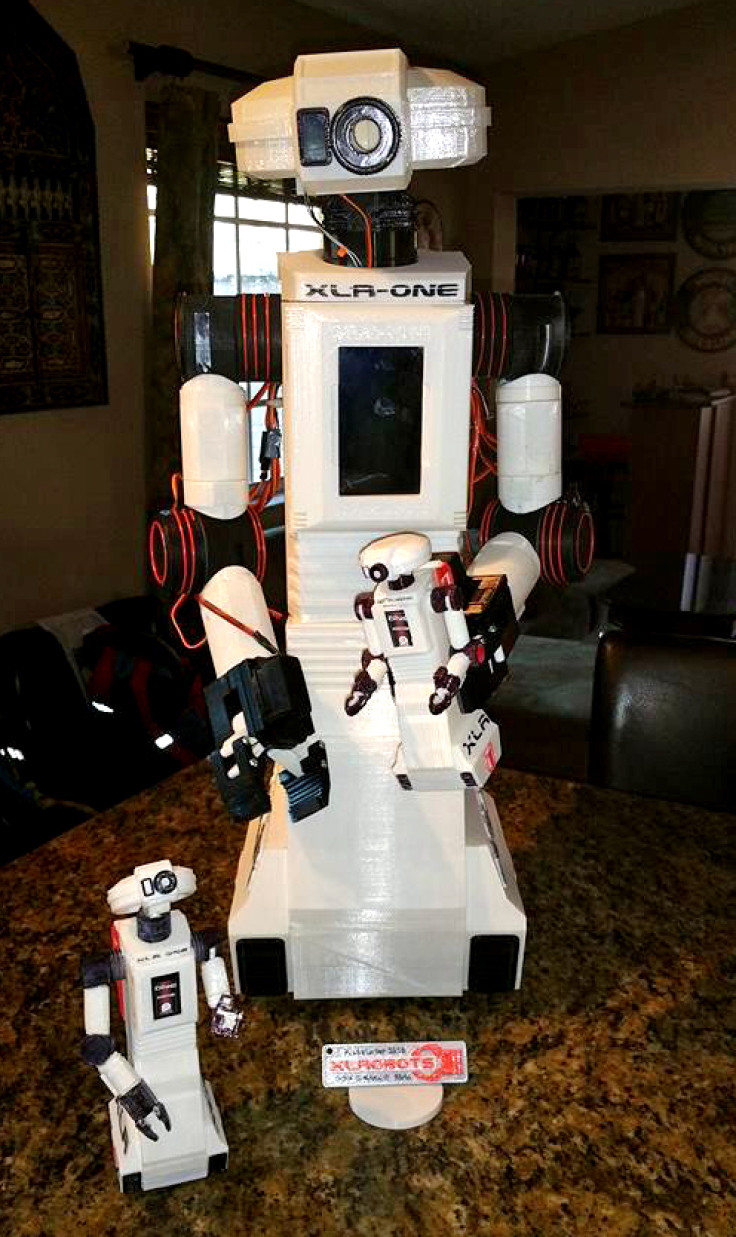XLR-One: Meet the 3D-printed robot companion that talks, tutors your child and DJs parties

A graphic designer and florist has created a customised 3D-printed personal robot companion that has a huge range of abilities - from entertaining users by talking and dancing, to being a party DJ or a home security patrol guard - but without a hefty price tag.
The XLR-One Personal Robot Companion is 30in tall and moves using a wheeled base. It has a Wi-Fi camera for an eye, and it looks and talks a lot like Short Circuit's Johnny Five.
Like Johnny, the robot has claws that open and close to grab and hold objects, and its head, wrists, elbows and shoulders all have 180 degrees of motion. But it can also do a lot of things that until now have only been possible in movies.
"I can have the robot be a home security system, it can be a virtual presence. I use it to interact with my children and teach them math. It can DJ your party. It has a lot of potential to grow. Whatever comes into your mind is possible," Anthony Ameralis, 47, the CEO of XLRobots and the owner of Miami-based flower business Just My Florist tells IBTimes UK.
Making personal robotics affordable to the average Joe
Hobby-based robotics is a rising trend that has become more feasible in recent years with the advent of smaller, more powerful processors and tiny credit-card computers such as the Raspberry Pi.
However, most of these robots look very rudimentary, with wires sticking out everywhere, and it is still difficult to get them to do anything beyond a simple task, such as cleaning the floor.
So how is it possible to get so much intelligence in a consumer robot, when the entry price to back it on Kickstarter is only $500 (£324) and up, as opposed to the robots being used in universities and research institutes that cost much more?
The secret, Ameralis explains, lies in the robot's brain and its operating system, both provided by Canadian firm EZ-Robot.
The robot's brain is the ez-bv4 Wi-Fi controller, which contains ARM Cortex-M3 & Microchip PIC32 and offers 200MHz of processing power, and the robot comes equipped with EZ-Robot Revolution, an easy-to-use robotics platform.
The platform allows users to use a simple custom control app on a tablet, where they can drag and drop what skills to teach the robot, such as vision tracking and learning, speech recognition and artificial intelligence.
"The ez-bv4 chip makes the Raspberry Pi look like your calculator. There's so much in it and it only costs $100, so it's affordable," Ameralis explained.
"To get a robot to do what my robot does at the same scale and to look like mine – those robots cost between $2,000 to $15,000, and that's ridiculous. People who want to get into home robotics don't have the money to invest in this."
Not having to worry about coding helps

Ameralis admits he has no background in coding, but that's no longer a problem. "For me, I've loved robots since I was a kid. I've always been a tinker – I used to take toys apart and make them better," he said.
"My background is in 3D modelling – my family just happens to be in the floral business. For years I've wanted to do this, but I didn't want to have to study programming and go through all the studies. Now with EZ-Robot I'm able to get everything going without having to worry about the coding."
The XLR-One Personal Robot Companion Kickstarter campaign currently has 10 backers pledging $5,697 out of the $10,000 goal, and there are five days left to go. But Ameralis is not concerned even if the campaign is not successful, and has already set a commercial release date of 1 June.
"We're launching the robots this year whether or not the Kickstarter is successful. I'm not so worried about the funding, I'm more concerned about bringing a product to market that I can be proud of," Ameralis said.
"And this is only the beginning. We've been working on excavating rovers, autonomous helicopter drones with six to eight rotors that can walk on the ground, and we want to make XLR-One 4.5-5ft high next."
© Copyright IBTimes 2024. All rights reserved.






